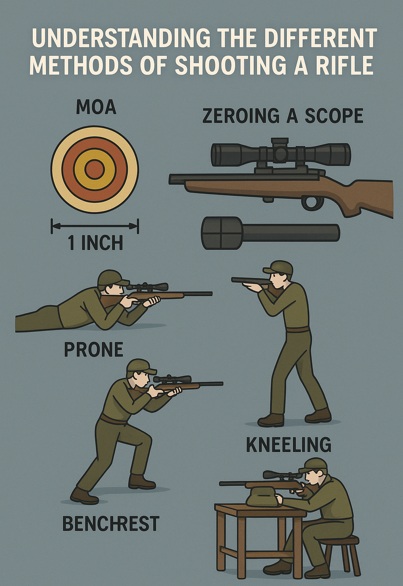Understanding the Different Methods of Shooting a Rifle: A Comprehensive Guide
Rifle shooting is a skill that combines precision, discipline, and technical knowledge. Whether you’re a beginner or looking to refine your skills, understanding the various methods of shooting, along with concepts like minute of angle (MOA) and zeroing a scope, is essential for improving accuracy and confidence. This guide breaks down key techniques and concepts to help you master rifle shooting.
Key Concepts in Rifle Shooting
1. Minute of Angle (MOA)
Minute of angle (MOA) is a critical concept for understanding rifle accuracy and making adjustments to your sights or scope. Here’s what you need to know:
- Definition: MOA is an angular measurement equal to 1/60th of a degree. At 100 yards, 1 MOA translates to approximately 1 inch.
- Practical Use:
- If your rifle’s impact point is 2 inches low at 100 yards, adjusting your scope by 2 MOA will bring the impact point to the bullseye.
- At 200 yards, 1 MOA equals about 2 inches, and at 300 yards, 3 inches, and so on.
- Scope Adjustments: Most modern rifle scopes adjust in increments of 1/4 MOA, meaning each click of the turret moves the point of impact by 1/4 inch at 100 yards.
2. Zeroing a Scope
Zeroing your rifle scope ensures that the point of aim aligns with the point of impact at a specific distance. This is a foundational skill for accurate shooting.
Steps to Zero Your Scope:
- Set Up a Stable Shooting Platform: Use a shooting bench, bipod, or sandbags to stabilise your rifle.
- Choose a Distance: Most shooters zero their scopes at 100 yards. Depending on your intended use, you might choose a different distance (e.g., 50 yards for small game hunting).
- Initial Alignment:
- Use a bore sighting tool or manually align the bore with the target by removing the bolt and looking through the barrel.
- Adjust the scope’s windage (left/right) and elevation (up/down) to match the bore alignment.
- Fire a Group: Shoot a three- or five-shot group at the target.
- Measure and Adjust: Measure the distance between the centre of the group and the bullseye, then adjust the scope turrets accordingly.
- Confirm Zero: Fire another group to ensure the adjustments have been correctly applied.
Shooting Techniques
1. Prone Position
The prone position is the most stable shooting stance, offering excellent accuracy.
- Setup: Lie flat on your stomach with your rifle supported by a bipod or sandbags.
- Key Points:
- Ensure the rifle butt is firmly seated in your shoulder pocket.
- Keep your elbows slightly apart for stability.
- Control your breathing and squeeze the trigger gently.
2. Standing Position
The standing position is the least stable but essential for shooting in the field.
- Setup: Stand with your feet shoulder-width apart and slightly staggered.
- Key Points:
- Support the rifle’s forearm with your non-dominant hand.
- Rest your elbow against your torso for additional support.
- Maintain a firm grip and follow through after each shot.
3. Kneeling Position
The kneeling position provides more stability than standing while allowing for quick adjustments.
- Setup: Place your dominant knee on the ground and your non-dominant knee forward, creating a triangle of support.
- Key Points:
- Rest your elbow on your raised knee for support.
- Keep your back straight and your weight centred.
4. Benchrest Shooting
Benchrest shooting is ideal for zeroing scopes and long-range accuracy practice.
- Setup: Use a shooting bench with a front rest or sandbags to stabilise the rifle.
- Key Points:
- Ensure the rifle is level and securely supported.
- Align your body with the rifle to minimise recoil effects.
- Focus on consistent trigger control.
Advanced Techniques
1. Breath Control
Breathing affects stability and accuracy. Learn to shoot during the natural respiratory pause:
- Exhale gently and pause before firing.
- Avoid holding your breath for extended periods to prevent muscle tension.
2. Trigger Control
Proper trigger control prevents jerking and improves shot placement:
- Place the pad of your index finger on the trigger.
- Apply steady, consistent pressure straight to the rear.
- Avoid slapping or yanking the trigger.
3. Follow Through
Follow through ensures consistent shot placement by maintaining focus and form after firing:
- Keep your eye on the target and maintain your shooting stance.
- Avoid moving the rifle immediately after the shot.
Ballistics Basics
Understanding ballistics helps you anticipate how your bullet will behave over distance:
- Bullet Drop: Bullets drop due to gravity. Knowing the trajectory of your ammunition helps in adjusting your aim for longer distances.
- Wind Drift: Wind affects bullet flight. Learn to read wind direction and speed, and compensate using scope adjustments or holdover.
- Velocity and Energy: Faster bullets experience less drop and drift but may lose energy over longer distances.
Practice and Training Tips
- Dry Fire Practice: Practise trigger control and aiming without live ammunition to build muscle memory.
- Range Time: Regularly visit shooting ranges to hone your skills and test your equipment.
- Keep a Logbook: Record your scope settings, environmental conditions, and results to track progress and identify patterns.
- Seek Professional Training: Enrol in a shooting course or hire an instructor for personalised guidance.
Conclusion
Mastering rifle shooting requires a combination of technical knowledge, practical skills, and consistent practice. By understanding concepts like MOA, zeroing a scope, and adopting proper shooting techniques, you’ll be well on your way to improving accuracy and confidence. Whether you’re shooting for sport, hunting, or competition, a disciplined approach will ensure safety and success.

